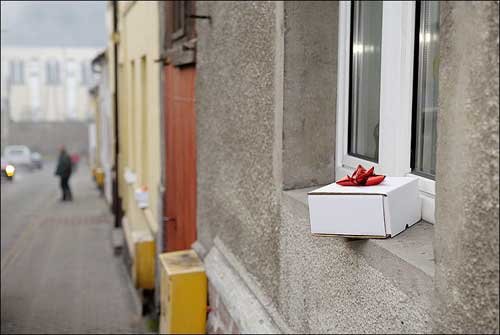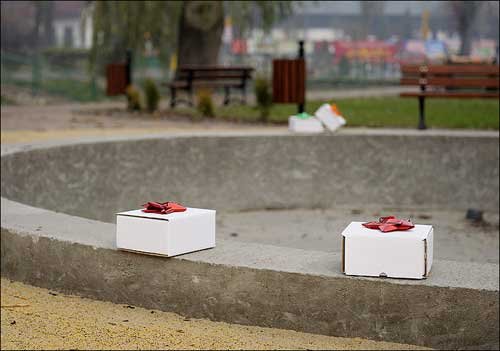LAZNIA 1 2009 - Under the bridge – Elżbieta Jabłońska Eight artistic interventions in the public space of Gdańsk and Liverpool
01.05-30.10.2009
Artists:
Liverpool – Garston: Dorota Buczkowska, Roman Dziadkiewicz, Elżbieta Jabłońska, Łukasz Jastrubczak
Gdańsk – Dolne Miasto: Ross Dalziel, Kevin Hunt, Maeve Rendle, Rita Slater
Curators: Agnieszka Kulazińska, Kevin Hunt, Rita Slater
Liverpool – Garston: Dorota Buczkowska, Roman Dziadkiewicz, Elżbieta Jabłońska, Łukasz Jastrubczak
Gdańsk – Dolne Miasto: Ross Dalziel, Kevin Hunt, Maeve Rendle, Rita Slater
Curators: Agnieszka Kulazińska, Kevin Hunt, Rita Slater

11 July 2009
Elżbieta Jabłońska
Elżbieta Jabłońska
Elżbieta Jabłońska` s ephemeral action will take place direct on the street of Garston early in the morning (around 6 a.m).
It will be noticeable only for viewers with eyes wide open.
It is a difficult task to describe Elżbieta Jabłońska’s artistic works. Her creations are often defined as post-feministic. This term however fails to indicate all the important aspects of her projects. Post-feminism sounds serious and grave, while her projects are full of little pleasures, simple, daily events. The artist in her works uses and transforms cultural stereotypes and clichés associated with woman and womanhood. She plays with them in an intelligent game, full of humour and warmth. One work of high importance for Jabłońska’s creative concept is her work from 2002, Supermother – a series of photographs, self-portraits with the artist dressed up as pop-culture superheroes – Superman, Batman and Spiderman. This work was an ironic comment on the situation of women in Poland – highlighting their strong attribution to the private, household zone due to motherhood’s physiology, while, on the other hand, work enhances their status. What can be wrong in being a Supermother – an ordinary woman who successfully combines her motherhood with a professional career? “The world is going round due to the Supermothers and not due to Supermen, but the efforts of Supermothers are not much socially appreciated and recognised. They are not stunning or spectacular, and the scene of the efforts is their private space (...)". Isn’t it high time for dethronement of the contemporary male heroes?
Can art be created out of banality and ordinary life? Art without huge, blow-up ideas? Jabłońska, making her socially involved art successfully, avoids pathos and presentation of the world in black and white. She manages to avoid typical traps – demagogy and social journalism. She speaks about important things in a simple way. As the Supermother she is the mother of the whole world – she helps, organizes vacations, cooks and makes presents. But is it possible to help everybody? In contemporary society the typically womanly works are embarrassing and enclosed in the four walls of private homes, marginalised. The artist makes them visible and enhances their status through art. An interesting aspect of her endeavours is the spectators’ responses to her projects. Very often they reveal feelings which are invisible, hidden in the course of everyday life.
Roads in the city space have a specific position – they are inside the city but at the same time they are outside it. They form the “living blood circulation” of a metropolis which is every day fuelled by thousands of incomers, and they constitute part of the city infrastructure. The word, infrastructure, is composed of two Latin words – infra and structura. The first one means “below” while the other means “a set” and a certain mutual relation between elements. Infrastructure is subordinated in its supporting function for production and consumption. What is then the position of a human in this set-up? Can there be more unfriendly space in a city than the space of dual carriageways, flyovers and bridges?
The starting point for the “Under the bridge” project is a space of two bridges – over Church Road in Garston, a suburban part of Liverpool, and in Gdansk over Szopy Street. What do they have in common? They are quite remote to each other in physical space.
The bridge in Garston was established in 1980 as part of a road leading to the centre of Liverpool. Its construction, once complete, changed the image of the district. The flyover has cut Garston, a “living urban body”, into two clearly separate parts. The part located close to the port changed from a typical English suburb into a moonscape, subject to constant transformation – the old houses are slowly being pulled down and replaced by new ones, and the area is undergoing intensive revitalisation.
Gdańsk bridge over Szopy Street is part of Podwale Przedmiejskie – a high speed road designed there during the Second World War. It divided Lower Town (Dolne Miasto) from the rest of Gdańsk, thus cementing the division into a historic part and a “poor” industrial part of the city.
A simple decision of city planners had a dramatic impact on the micro scale. Both bridges have become a border line, a space in between – a symbolic passage or transition between two incompatible worlds. As under a magnifying glass the two bridges show the problems of the districts. Having crossed the border line you feel as if teleported – you are suddenly transferred into a completely different space in time. In what way do the divisions made by the bridges influence the perception of space? What impact do they have on the consciousness of local people and of visitors?
“Under the bridge” is about the series of artistic interventions in the public and “mental” space of two bridges, and seeks to analyse the subconscious of the district, symbolically linking two spaces. Can art for at least a short while eliminate the ugliness of the two bridges? Will their oppressiveness disappear for a moment?
The artistic interventions will take place once a month. We have intentionally chosen to move away from the festival form for the benefit of long-term activities. Will such form have a stronger impact on the inhabitants? The “Under the bridge” project questions the role of art and artists in public space. Are they capable of influencing society? Are their ambitions nothing but utopia, or maybe just another fashionable trend of contemporary art? What is the place of man in the art infrastructure?
A. Kulazińska


Center for Contemporary Art Łaźnia, Ul. Jaskółcza 1, 80-767 Gdańsk
phone: 0048583054050, office@laznia.pl, www.laznia.pl
Project “Under the bridge” originally developed as a part of “For The Likes Of Us...” an exchange programme between the Liverpool Biennial Big Table partners and 'corresponding' organisations across Europe, contributing towards the objectives of the Cities on the Edge network.
Under the bridge is within the framework of POLSKA YEAR! in the UK
Under the bridge is supported by the Ministry of Culture and National Heritage of Republic of Poland
phone: 0048583054050, office@laznia.pl, www.laznia.pl
Project “Under the bridge” originally developed as a part of “For The Likes Of Us...” an exchange programme between the Liverpool Biennial Big Table partners and 'corresponding' organisations across Europe, contributing towards the objectives of the Cities on the Edge network.
Under the bridge is within the framework of POLSKA YEAR! in the UK
Under the bridge is supported by the Ministry of Culture and National Heritage of Republic of Poland






 BIP
BIP